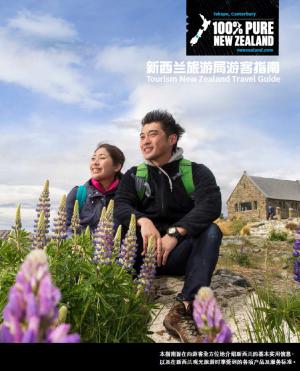
For a small island nation, tucked away in the South Pacific, New Zealand has an interesting challenge: to attract tourists to its picturesque shores, but not too many.
With limited space and beds, Tourism New Zealand, the country’s marketing body, must balance the country’s booming tourism industry with practical sustainability. In China, this translates to a strategy to target high-spending travellers. However, with tourism organisations from around the world competing for China’s 145 million outbound travellers, cutting through all the noise can be a challenge.
Kieran O’Donnell, the North Asia regional marketing & communications manager for Tourism New Zealand told The Drum: “One of the big things to note about the China market is that only 10% of the population have passports, and there’s a lot of competition trying to attract those outbound travellers.”
New Zealand attracts just 0.3% of China’s outbound travellers, which is around 400,000 visitors annually. O’Donnell says targeting that section of the market in China is “like finding a needle in the haystack”.
To target those needles, Tourism New Zealand partnered with Tencent to run targeted advertising on WeChat and set a new benchmark for the industry with a nearly 10% click-through rate (CTR) in the process.
“We achieved the highest click-through rates of any brand in the travel industry on WeChat,” says O’Donnell. “We more than doubled the CTRs of our closest competitor and achieved more than ten times that of the tourism industry average. Our work is now a best practice case study for Tencent.”
It is an impressive achievement for New Zealand, a country which often struggles to be included on maps. However, despite its small size – and small budgets – the marketing organisation outperforms much larger tourism rivals such as Australia and the United States.
Tourism New Zealand has built a strong brand platform thanks to its iconic ‘100% Pure New Zealand’ tagline, which launched in 1999 and is often referred to as one of the strongest and most admired destination brands globally. While Tourism New Zealand has a legacy of breathtaking TV campaigns, as well as benefitting from the halo effect of the Lord of The Rings and Hobbit franchises, marketing to China is a completely different ballpark, where this legacy is not well known and digital is everything.
The partnership with WeChat, which boasts more than a billion users, was a crucial strategy to engage with Chinese consumers.
“Chinese travellers are the biggest spenders per day, so they are very important to our economy and the key is to get more of them. Our strategy is to target high-value Chinese travellers and encourage them to visit New Zealand,” said O’Donnell.
“We had worked with Tencent since 2014 so our relationship has been an evolution rather than a revolution. Initially, our strategy was about establishing a presence and growing advocacy. We shared content: images and itineraries as well as leveraging global initiatives such as The Hobbit and Lord of The Rings films. However, the step change for us came when we began to target and re-target advertising towards consumers.”
“By targeting active considers of New Zealand, people we knew were interested in New Zealand and were willing to spend a certain amount of money on a holiday, we were able to convert them to travel to New Zealand within their next two holidays,” added O’Donnell.
TNZ identified that many of its more than 30m active considers in China use a number of platforms within the Tencent ecosystem. The strategy was to continue to target these users and drive them through their purchase funnel from dreaming about a New Zealand holiday through to the planning process and ultimately converting them to booking a trip.
“It’s not always linear, there are people who are willing to go and just buy a ticket, these are the low-hanging fruit, but overall Chinese travellers have a lot of questions before they travel and this process aims to answer those and help them through the process.”
Tourism New Zealand targeted consumers using WeChat’s Ad Moments and followed them across the Tencent / WeChat ecosystem to retarget them, driving a 236% increase in active visits, as well as a 254% surge in referrals.
“This program showed us that when we target consumers this way, they stay with us and move through the purchase funnel. While the purchase funnel is usually a rectangle, with fewer consumers moving through the funnel from consideration right through to booking, however with this campaign, our funnel was a rectangle, as consumers stayed with us the whole way through the funnel,” continued O’Donnell.
“The most efficient media for TNZ globally is using search, whether it is Google or Baidu, in terms of referrals, this campaign had a higher referral rate than search, which illustrates the potential of WeChat. That’s what excites us about WeChat, it’s an environment that is uncluttered as when you book an ad that is the only one your target audience will see that day.”
The activity also led to a significant surge in mobile traffic, which is a key growth metric for TNZ in the China market, and also jumped from 30% to 66%.
“Tourism New Zealand was predominantly a PC organisation, all of our content was built for PC and then retrospectively converted across to mobile. However, with the China market, which is such a mobile-centric market, we’ve had to change that approach completely and it has shifted the activity we do in this market. And that is reflected in our mobile traffic and that is growing as we do more and more with Tencent.”

“The power of WeChat is so much more than the messaging element of the app and to only view WeChat as a social media app is to really miss the point and the potential. When used strategically it represents an immensely powerful media channel. As a brand, the access you gain to the wider Tencent ecosystem and the data available is invaluable. For a brand like Tourism New Zealand, which is ultimately a small government organisation, leveraging the Tencent / WeChat platform for marketing has been a game-changer,” commented O’Donnell.
“The 100% Pure brand has been around for 20 years and it is a testament to this consistent messaging that we, as an organisation, are able to take risks, be innovative and explore new technologies. Tourism New Zealand has always prided itself as being an early adopter and when we started working with Tencent back in 2014, we were certainly ahead of the curve.
“The challenge for us as a brand going forward is to make sure we can stay ahead of the competition and without the large budgets of much bigger rivals, we have to be smart and strategic in everything we do. The world is becoming a much smaller place in terms of travel and the competition is fiercer than ever. The challenge for Tourism New Zealand is to continue to identify the new and innovative opportunities to be an early adopter, and to engage with consumers and make sure people keep booking holidays to New Zealand,” says O’Donnell.
To continue to make WeChat relevant for brands and advertisers, Tencent recently announced it will be introducing more advertising formats and increasing the inventory available on the platform.
Source: The Drum

You must be logged in to post a comment Login